Report on Engie's Capital Structure and Working Capital Management
VerifiedAdded on 2023/01/17
|7
|2322
|49
Report
AI Summary
This report provides a comprehensive analysis of Engie's capital structure and working capital management. It begins with an introduction to Engie, a French multinational company, and its financial performance. The main body of the report delves into Engie's capital structure, comparing debt and equ...

Coursework
Secure Best Marks with AI Grader
Need help grading? Try our AI Grader for instant feedback on your assignments.
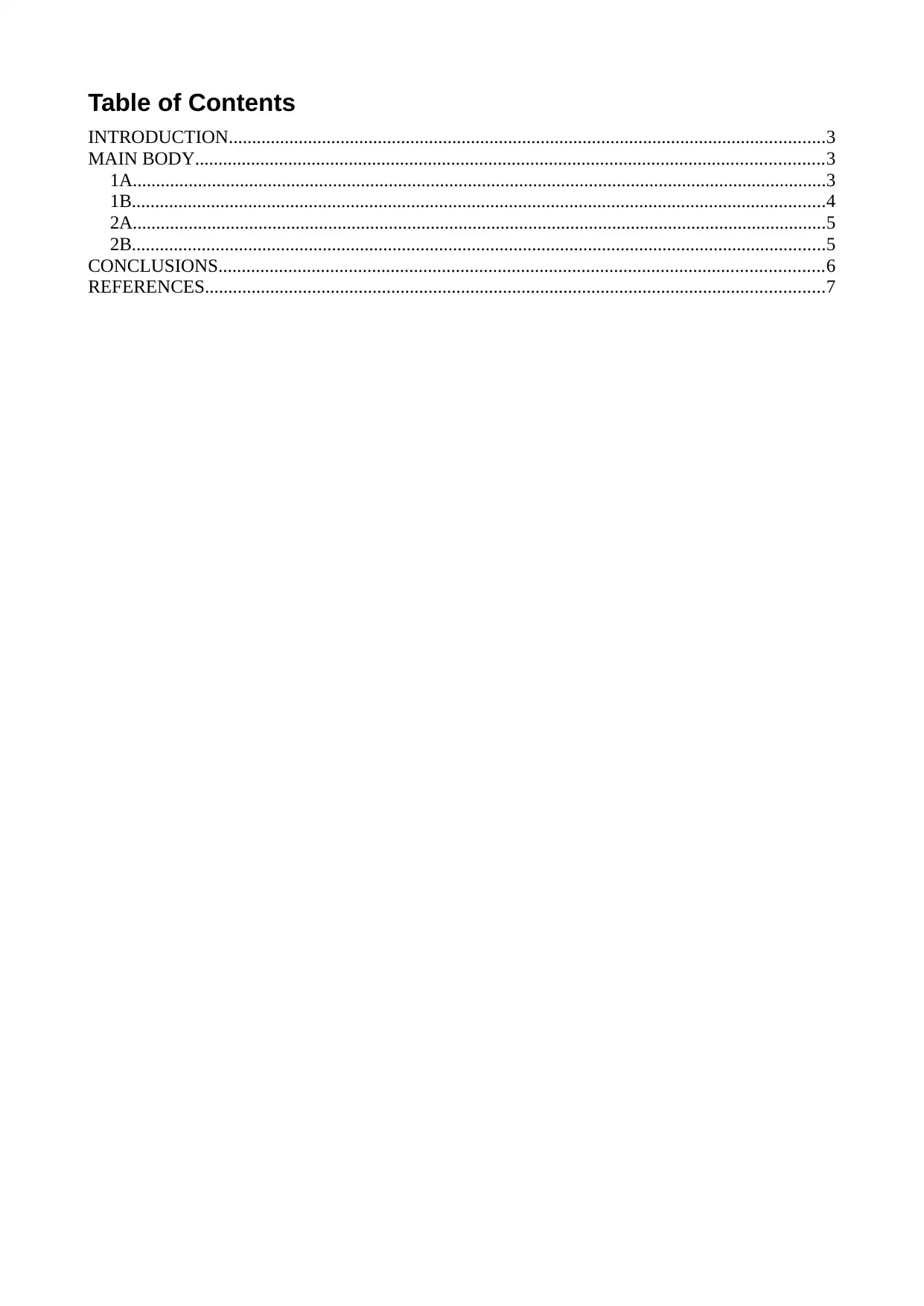
Table of Contents
INTRODUCTION................................................................................................................................3
MAIN BODY.......................................................................................................................................3
1A.....................................................................................................................................................3
1B.....................................................................................................................................................4
2A.....................................................................................................................................................5
2B.....................................................................................................................................................5
CONCLUSIONS..................................................................................................................................6
REFERENCES.....................................................................................................................................7
INTRODUCTION................................................................................................................................3
MAIN BODY.......................................................................................................................................3
1A.....................................................................................................................................................3
1B.....................................................................................................................................................4
2A.....................................................................................................................................................5
2B.....................................................................................................................................................5
CONCLUSIONS..................................................................................................................................6
REFERENCES.....................................................................................................................................7
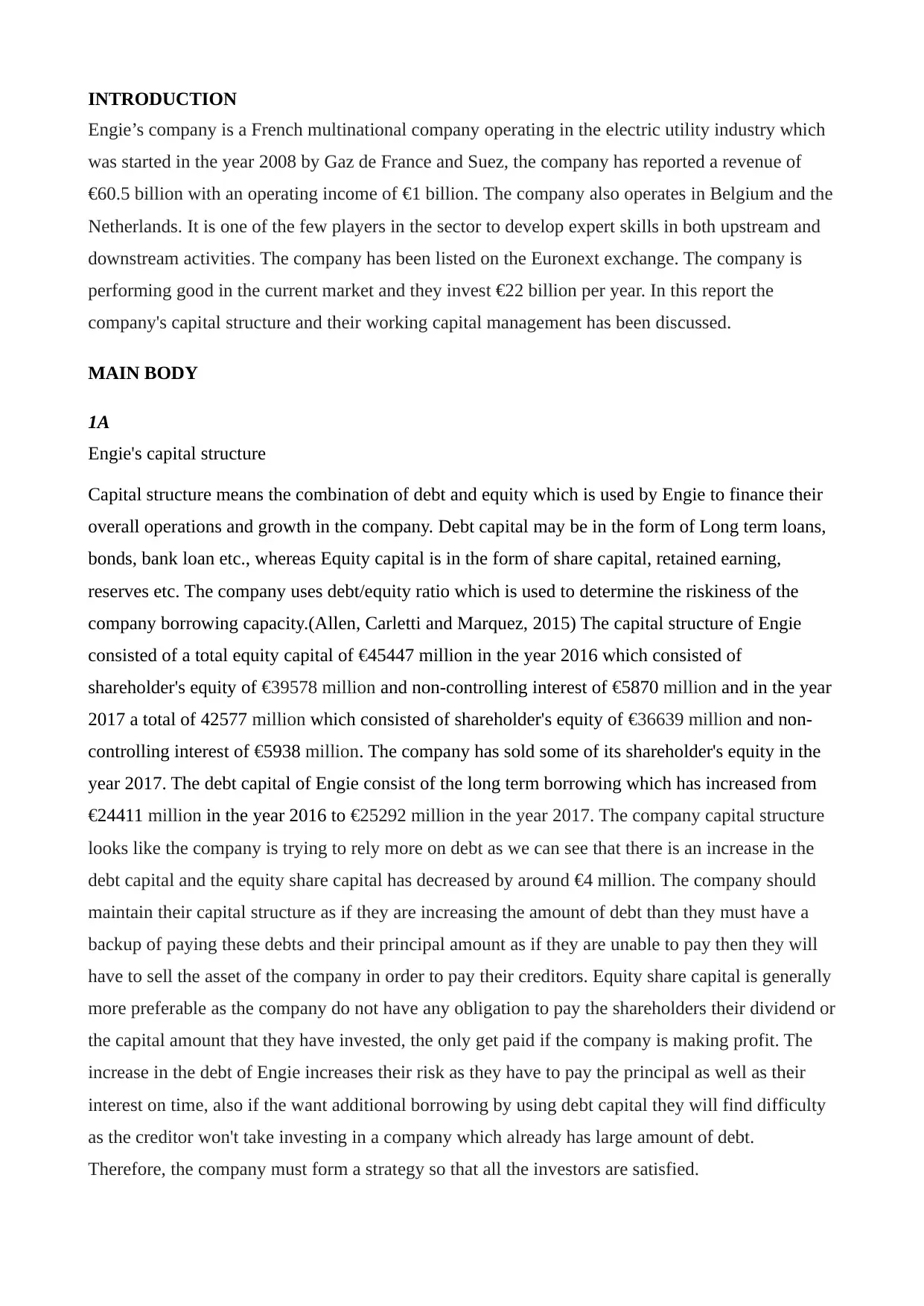
INTRODUCTION
Engie’s company is a French multinational company operating in the electric utility industry which
was started in the year 2008 by Gaz de France and Suez, the company has reported a revenue of
€60.5 billion with an operating income of €1 billion. The company also operates in Belgium and the
Netherlands. It is one of the few players in the sector to develop expert skills in both upstream and
downstream activities. The company has been listed on the Euronext exchange. The company is
performing good in the current market and they invest €22 billion per year. In this report the
company's capital structure and their working capital management has been discussed.
MAIN BODY
1A
Engie's capital structure
Capital structure means the combination of debt and equity which is used by Engie to finance their
overall operations and growth in the company. Debt capital may be in the form of Long term loans,
bonds, bank loan etc., whereas Equity capital is in the form of share capital, retained earning,
reserves etc. The company uses debt/equity ratio which is used to determine the riskiness of the
company borrowing capacity.(Allen, Carletti and Marquez, 2015) The capital structure of Engie
consisted of a total equity capital of €45447 million in the year 2016 which consisted of
shareholder's equity of €39578 million and non-controlling interest of €5870 million and in the year
2017 a total of 42577 million which consisted of shareholder's equity of €36639 million and non-
controlling interest of €5938 million. The company has sold some of its shareholder's equity in the
year 2017. The debt capital of Engie consist of the long term borrowing which has increased from
€24411 million in the year 2016 to €25292 million in the year 2017. The company capital structure
looks like the company is trying to rely more on debt as we can see that there is an increase in the
debt capital and the equity share capital has decreased by around €4 million. The company should
maintain their capital structure as if they are increasing the amount of debt than they must have a
backup of paying these debts and their principal amount as if they are unable to pay then they will
have to sell the asset of the company in order to pay their creditors. Equity share capital is generally
more preferable as the company do not have any obligation to pay the shareholders their dividend or
the capital amount that they have invested, the only get paid if the company is making profit. The
increase in the debt of Engie increases their risk as they have to pay the principal as well as their
interest on time, also if the want additional borrowing by using debt capital they will find difficulty
as the creditor won't take investing in a company which already has large amount of debt.
Therefore, the company must form a strategy so that all the investors are satisfied.
Engie’s company is a French multinational company operating in the electric utility industry which
was started in the year 2008 by Gaz de France and Suez, the company has reported a revenue of
€60.5 billion with an operating income of €1 billion. The company also operates in Belgium and the
Netherlands. It is one of the few players in the sector to develop expert skills in both upstream and
downstream activities. The company has been listed on the Euronext exchange. The company is
performing good in the current market and they invest €22 billion per year. In this report the
company's capital structure and their working capital management has been discussed.
MAIN BODY
1A
Engie's capital structure
Capital structure means the combination of debt and equity which is used by Engie to finance their
overall operations and growth in the company. Debt capital may be in the form of Long term loans,
bonds, bank loan etc., whereas Equity capital is in the form of share capital, retained earning,
reserves etc. The company uses debt/equity ratio which is used to determine the riskiness of the
company borrowing capacity.(Allen, Carletti and Marquez, 2015) The capital structure of Engie
consisted of a total equity capital of €45447 million in the year 2016 which consisted of
shareholder's equity of €39578 million and non-controlling interest of €5870 million and in the year
2017 a total of 42577 million which consisted of shareholder's equity of €36639 million and non-
controlling interest of €5938 million. The company has sold some of its shareholder's equity in the
year 2017. The debt capital of Engie consist of the long term borrowing which has increased from
€24411 million in the year 2016 to €25292 million in the year 2017. The company capital structure
looks like the company is trying to rely more on debt as we can see that there is an increase in the
debt capital and the equity share capital has decreased by around €4 million. The company should
maintain their capital structure as if they are increasing the amount of debt than they must have a
backup of paying these debts and their principal amount as if they are unable to pay then they will
have to sell the asset of the company in order to pay their creditors. Equity share capital is generally
more preferable as the company do not have any obligation to pay the shareholders their dividend or
the capital amount that they have invested, the only get paid if the company is making profit. The
increase in the debt of Engie increases their risk as they have to pay the principal as well as their
interest on time, also if the want additional borrowing by using debt capital they will find difficulty
as the creditor won't take investing in a company which already has large amount of debt.
Therefore, the company must form a strategy so that all the investors are satisfied.
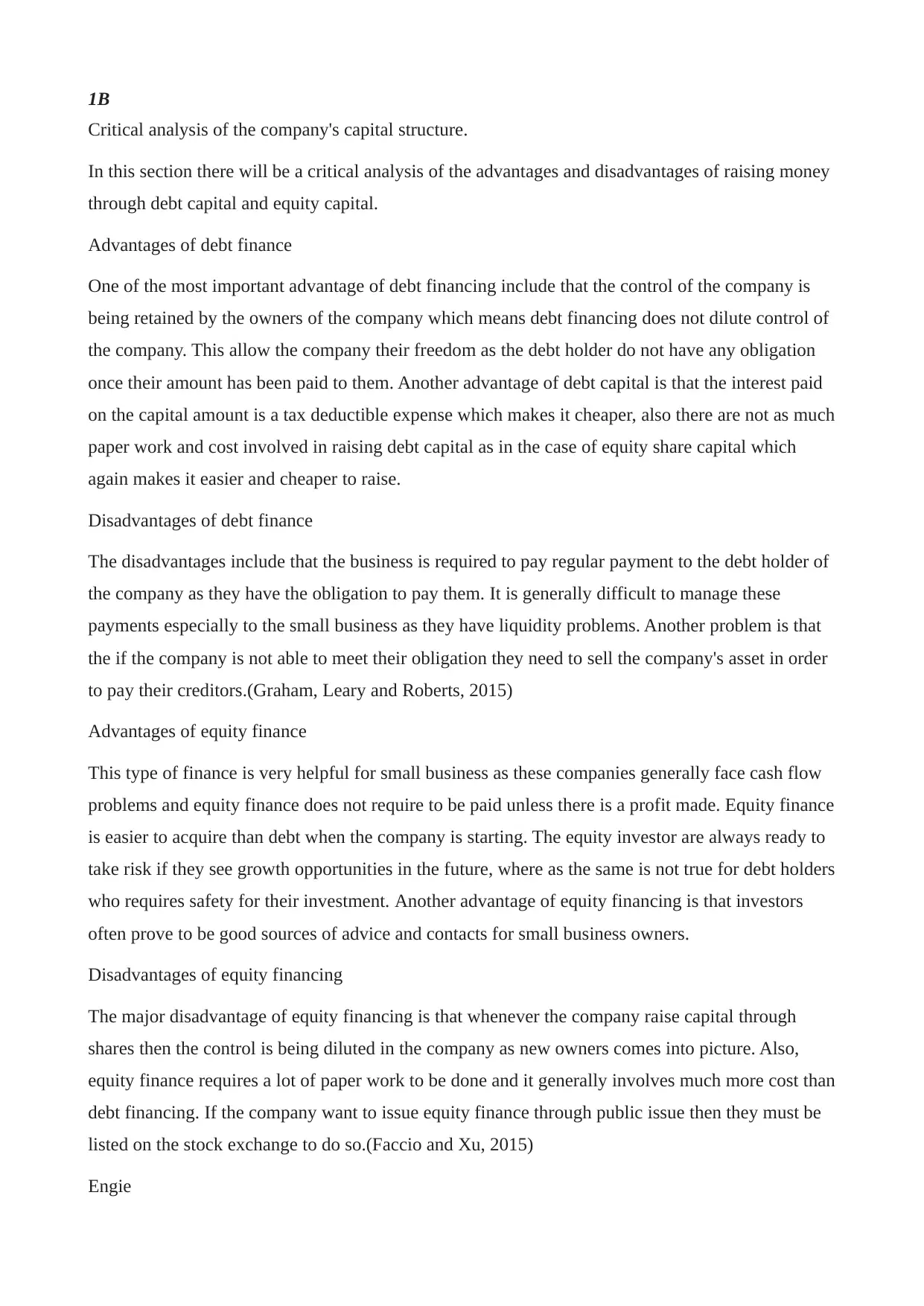
1B
Critical analysis of the company's capital structure.
In this section there will be a critical analysis of the advantages and disadvantages of raising money
through debt capital and equity capital.
Advantages of debt finance
One of the most important advantage of debt financing include that the control of the company is
being retained by the owners of the company which means debt financing does not dilute control of
the company. This allow the company their freedom as the debt holder do not have any obligation
once their amount has been paid to them. Another advantage of debt capital is that the interest paid
on the capital amount is a tax deductible expense which makes it cheaper, also there are not as much
paper work and cost involved in raising debt capital as in the case of equity share capital which
again makes it easier and cheaper to raise.
Disadvantages of debt finance
The disadvantages include that the business is required to pay regular payment to the debt holder of
the company as they have the obligation to pay them. It is generally difficult to manage these
payments especially to the small business as they have liquidity problems. Another problem is that
the if the company is not able to meet their obligation they need to sell the company's asset in order
to pay their creditors.(Graham, Leary and Roberts, 2015)
Advantages of equity finance
This type of finance is very helpful for small business as these companies generally face cash flow
problems and equity finance does not require to be paid unless there is a profit made. Equity finance
is easier to acquire than debt when the company is starting. The equity investor are always ready to
take risk if they see growth opportunities in the future, where as the same is not true for debt holders
who requires safety for their investment. Another advantage of equity financing is that investors
often prove to be good sources of advice and contacts for small business owners.
Disadvantages of equity financing
The major disadvantage of equity financing is that whenever the company raise capital through
shares then the control is being diluted in the company as new owners comes into picture. Also,
equity finance requires a lot of paper work to be done and it generally involves much more cost than
debt financing. If the company want to issue equity finance through public issue then they must be
listed on the stock exchange to do so.(Faccio and Xu, 2015)
Engie
Critical analysis of the company's capital structure.
In this section there will be a critical analysis of the advantages and disadvantages of raising money
through debt capital and equity capital.
Advantages of debt finance
One of the most important advantage of debt financing include that the control of the company is
being retained by the owners of the company which means debt financing does not dilute control of
the company. This allow the company their freedom as the debt holder do not have any obligation
once their amount has been paid to them. Another advantage of debt capital is that the interest paid
on the capital amount is a tax deductible expense which makes it cheaper, also there are not as much
paper work and cost involved in raising debt capital as in the case of equity share capital which
again makes it easier and cheaper to raise.
Disadvantages of debt finance
The disadvantages include that the business is required to pay regular payment to the debt holder of
the company as they have the obligation to pay them. It is generally difficult to manage these
payments especially to the small business as they have liquidity problems. Another problem is that
the if the company is not able to meet their obligation they need to sell the company's asset in order
to pay their creditors.(Graham, Leary and Roberts, 2015)
Advantages of equity finance
This type of finance is very helpful for small business as these companies generally face cash flow
problems and equity finance does not require to be paid unless there is a profit made. Equity finance
is easier to acquire than debt when the company is starting. The equity investor are always ready to
take risk if they see growth opportunities in the future, where as the same is not true for debt holders
who requires safety for their investment. Another advantage of equity financing is that investors
often prove to be good sources of advice and contacts for small business owners.
Disadvantages of equity financing
The major disadvantage of equity financing is that whenever the company raise capital through
shares then the control is being diluted in the company as new owners comes into picture. Also,
equity finance requires a lot of paper work to be done and it generally involves much more cost than
debt financing. If the company want to issue equity finance through public issue then they must be
listed on the stock exchange to do so.(Faccio and Xu, 2015)
Engie
Secure Best Marks with AI Grader
Need help grading? Try our AI Grader for instant feedback on your assignments.
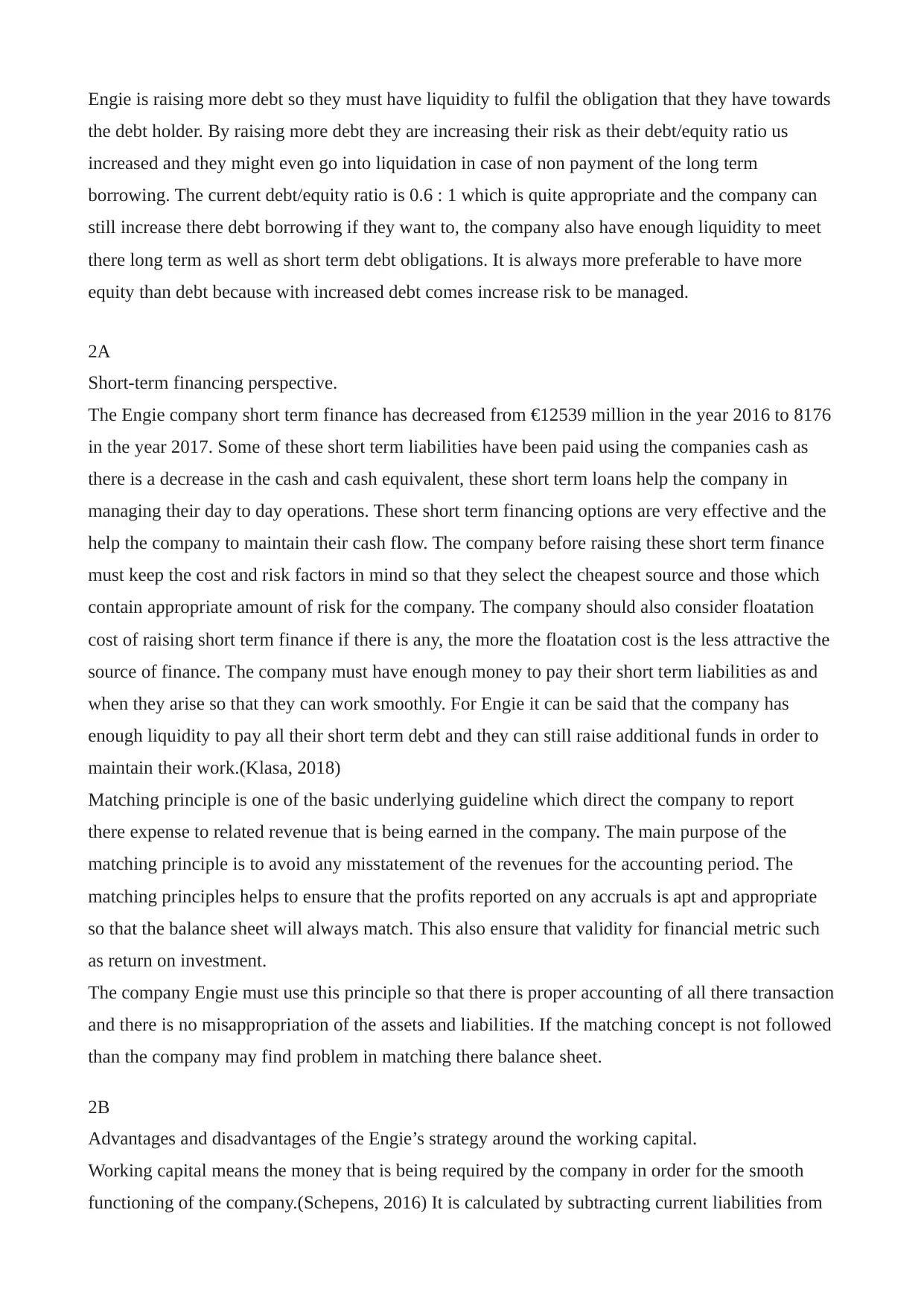
Engie is raising more debt so they must have liquidity to fulfil the obligation that they have towards
the debt holder. By raising more debt they are increasing their risk as their debt/equity ratio us
increased and they might even go into liquidation in case of non payment of the long term
borrowing. The current debt/equity ratio is 0.6 : 1 which is quite appropriate and the company can
still increase there debt borrowing if they want to, the company also have enough liquidity to meet
there long term as well as short term debt obligations. It is always more preferable to have more
equity than debt because with increased debt comes increase risk to be managed.
2A
Short-term financing perspective.
The Engie company short term finance has decreased from €12539 million in the year 2016 to 8176
in the year 2017. Some of these short term liabilities have been paid using the companies cash as
there is a decrease in the cash and cash equivalent, these short term loans help the company in
managing their day to day operations. These short term financing options are very effective and the
help the company to maintain their cash flow. The company before raising these short term finance
must keep the cost and risk factors in mind so that they select the cheapest source and those which
contain appropriate amount of risk for the company. The company should also consider floatation
cost of raising short term finance if there is any, the more the floatation cost is the less attractive the
source of finance. The company must have enough money to pay their short term liabilities as and
when they arise so that they can work smoothly. For Engie it can be said that the company has
enough liquidity to pay all their short term debt and they can still raise additional funds in order to
maintain their work.(Klasa, 2018)
Matching principle is one of the basic underlying guideline which direct the company to report
there expense to related revenue that is being earned in the company. The main purpose of the
matching principle is to avoid any misstatement of the revenues for the accounting period. The
matching principles helps to ensure that the profits reported on any accruals is apt and appropriate
so that the balance sheet will always match. This also ensure that validity for financial metric such
as return on investment.
The company Engie must use this principle so that there is proper accounting of all there transaction
and there is no misappropriation of the assets and liabilities. If the matching concept is not followed
than the company may find problem in matching there balance sheet.
2B
Advantages and disadvantages of the Engie’s strategy around the working capital.
Working capital means the money that is being required by the company in order for the smooth
functioning of the company.(Schepens, 2016) It is calculated by subtracting current liabilities from
the debt holder. By raising more debt they are increasing their risk as their debt/equity ratio us
increased and they might even go into liquidation in case of non payment of the long term
borrowing. The current debt/equity ratio is 0.6 : 1 which is quite appropriate and the company can
still increase there debt borrowing if they want to, the company also have enough liquidity to meet
there long term as well as short term debt obligations. It is always more preferable to have more
equity than debt because with increased debt comes increase risk to be managed.
2A
Short-term financing perspective.
The Engie company short term finance has decreased from €12539 million in the year 2016 to 8176
in the year 2017. Some of these short term liabilities have been paid using the companies cash as
there is a decrease in the cash and cash equivalent, these short term loans help the company in
managing their day to day operations. These short term financing options are very effective and the
help the company to maintain their cash flow. The company before raising these short term finance
must keep the cost and risk factors in mind so that they select the cheapest source and those which
contain appropriate amount of risk for the company. The company should also consider floatation
cost of raising short term finance if there is any, the more the floatation cost is the less attractive the
source of finance. The company must have enough money to pay their short term liabilities as and
when they arise so that they can work smoothly. For Engie it can be said that the company has
enough liquidity to pay all their short term debt and they can still raise additional funds in order to
maintain their work.(Klasa, 2018)
Matching principle is one of the basic underlying guideline which direct the company to report
there expense to related revenue that is being earned in the company. The main purpose of the
matching principle is to avoid any misstatement of the revenues for the accounting period. The
matching principles helps to ensure that the profits reported on any accruals is apt and appropriate
so that the balance sheet will always match. This also ensure that validity for financial metric such
as return on investment.
The company Engie must use this principle so that there is proper accounting of all there transaction
and there is no misappropriation of the assets and liabilities. If the matching concept is not followed
than the company may find problem in matching there balance sheet.
2B
Advantages and disadvantages of the Engie’s strategy around the working capital.
Working capital means the money that is being required by the company in order for the smooth
functioning of the company.(Schepens, 2016) It is calculated by subtracting current liabilities from
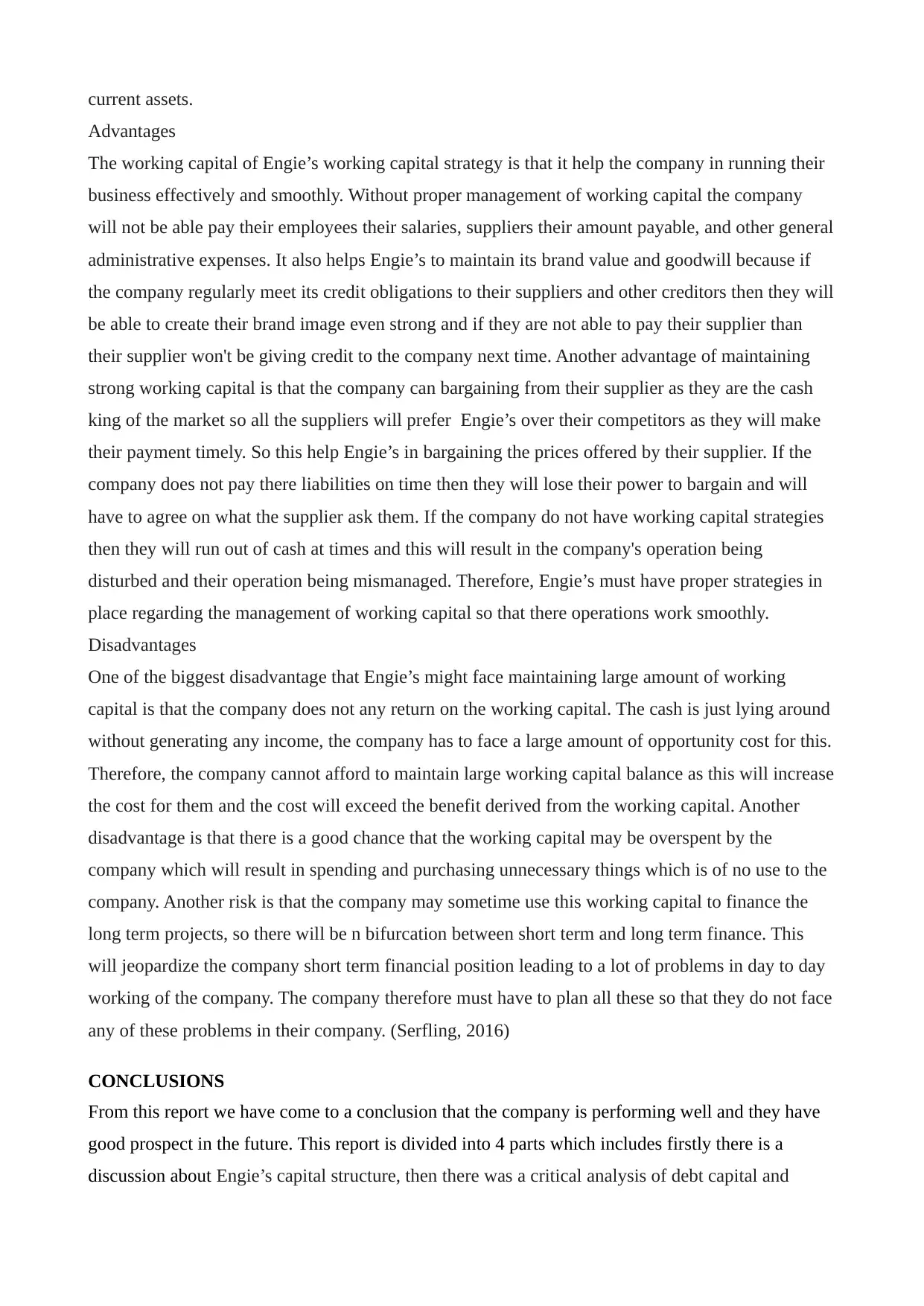
current assets.
Advantages
The working capital of Engie’s working capital strategy is that it help the company in running their
business effectively and smoothly. Without proper management of working capital the company
will not be able pay their employees their salaries, suppliers their amount payable, and other general
administrative expenses. It also helps Engie’s to maintain its brand value and goodwill because if
the company regularly meet its credit obligations to their suppliers and other creditors then they will
be able to create their brand image even strong and if they are not able to pay their supplier than
their supplier won't be giving credit to the company next time. Another advantage of maintaining
strong working capital is that the company can bargaining from their supplier as they are the cash
king of the market so all the suppliers will prefer Engie’s over their competitors as they will make
their payment timely. So this help Engie’s in bargaining the prices offered by their supplier. If the
company does not pay there liabilities on time then they will lose their power to bargain and will
have to agree on what the supplier ask them. If the company do not have working capital strategies
then they will run out of cash at times and this will result in the company's operation being
disturbed and their operation being mismanaged. Therefore, Engie’s must have proper strategies in
place regarding the management of working capital so that there operations work smoothly.
Disadvantages
One of the biggest disadvantage that Engie’s might face maintaining large amount of working
capital is that the company does not any return on the working capital. The cash is just lying around
without generating any income, the company has to face a large amount of opportunity cost for this.
Therefore, the company cannot afford to maintain large working capital balance as this will increase
the cost for them and the cost will exceed the benefit derived from the working capital. Another
disadvantage is that there is a good chance that the working capital may be overspent by the
company which will result in spending and purchasing unnecessary things which is of no use to the
company. Another risk is that the company may sometime use this working capital to finance the
long term projects, so there will be n bifurcation between short term and long term finance. This
will jeopardize the company short term financial position leading to a lot of problems in day to day
working of the company. The company therefore must have to plan all these so that they do not face
any of these problems in their company. (Serfling, 2016)
CONCLUSIONS
From this report we have come to a conclusion that the company is performing well and they have
good prospect in the future. This report is divided into 4 parts which includes firstly there is a
discussion about Engie’s capital structure, then there was a critical analysis of debt capital and
Advantages
The working capital of Engie’s working capital strategy is that it help the company in running their
business effectively and smoothly. Without proper management of working capital the company
will not be able pay their employees their salaries, suppliers their amount payable, and other general
administrative expenses. It also helps Engie’s to maintain its brand value and goodwill because if
the company regularly meet its credit obligations to their suppliers and other creditors then they will
be able to create their brand image even strong and if they are not able to pay their supplier than
their supplier won't be giving credit to the company next time. Another advantage of maintaining
strong working capital is that the company can bargaining from their supplier as they are the cash
king of the market so all the suppliers will prefer Engie’s over their competitors as they will make
their payment timely. So this help Engie’s in bargaining the prices offered by their supplier. If the
company does not pay there liabilities on time then they will lose their power to bargain and will
have to agree on what the supplier ask them. If the company do not have working capital strategies
then they will run out of cash at times and this will result in the company's operation being
disturbed and their operation being mismanaged. Therefore, Engie’s must have proper strategies in
place regarding the management of working capital so that there operations work smoothly.
Disadvantages
One of the biggest disadvantage that Engie’s might face maintaining large amount of working
capital is that the company does not any return on the working capital. The cash is just lying around
without generating any income, the company has to face a large amount of opportunity cost for this.
Therefore, the company cannot afford to maintain large working capital balance as this will increase
the cost for them and the cost will exceed the benefit derived from the working capital. Another
disadvantage is that there is a good chance that the working capital may be overspent by the
company which will result in spending and purchasing unnecessary things which is of no use to the
company. Another risk is that the company may sometime use this working capital to finance the
long term projects, so there will be n bifurcation between short term and long term finance. This
will jeopardize the company short term financial position leading to a lot of problems in day to day
working of the company. The company therefore must have to plan all these so that they do not face
any of these problems in their company. (Serfling, 2016)
CONCLUSIONS
From this report we have come to a conclusion that the company is performing well and they have
good prospect in the future. This report is divided into 4 parts which includes firstly there is a
discussion about Engie’s capital structure, then there was a critical analysis of debt capital and
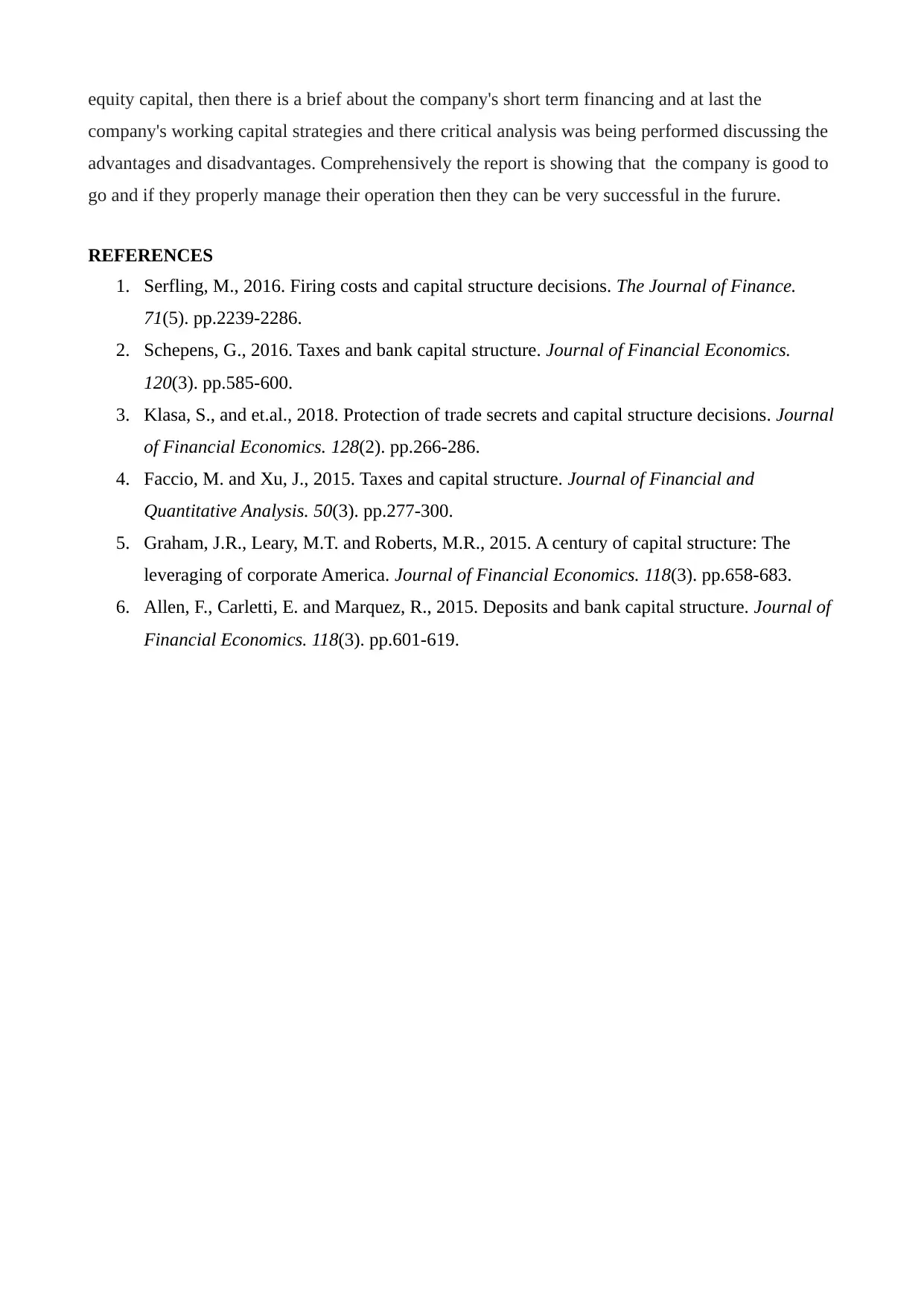
equity capital, then there is a brief about the company's short term financing and at last the
company's working capital strategies and there critical analysis was being performed discussing the
advantages and disadvantages. Comprehensively the report is showing that the company is good to
go and if they properly manage their operation then they can be very successful in the furure.
REFERENCES
1. Serfling, M., 2016. Firing costs and capital structure decisions. The Journal of Finance.
71(5). pp.2239-2286.
2. Schepens, G., 2016. Taxes and bank capital structure. Journal of Financial Economics.
120(3). pp.585-600.
3. Klasa, S., and et.al., 2018. Protection of trade secrets and capital structure decisions. Journal
of Financial Economics. 128(2). pp.266-286.
4. Faccio, M. and Xu, J., 2015. Taxes and capital structure. Journal of Financial and
Quantitative Analysis. 50(3). pp.277-300.
5. Graham, J.R., Leary, M.T. and Roberts, M.R., 2015. A century of capital structure: The
leveraging of corporate America. Journal of Financial Economics. 118(3). pp.658-683.
6. Allen, F., Carletti, E. and Marquez, R., 2015. Deposits and bank capital structure. Journal of
Financial Economics. 118(3). pp.601-619.
company's working capital strategies and there critical analysis was being performed discussing the
advantages and disadvantages. Comprehensively the report is showing that the company is good to
go and if they properly manage their operation then they can be very successful in the furure.
REFERENCES
1. Serfling, M., 2016. Firing costs and capital structure decisions. The Journal of Finance.
71(5). pp.2239-2286.
2. Schepens, G., 2016. Taxes and bank capital structure. Journal of Financial Economics.
120(3). pp.585-600.
3. Klasa, S., and et.al., 2018. Protection of trade secrets and capital structure decisions. Journal
of Financial Economics. 128(2). pp.266-286.
4. Faccio, M. and Xu, J., 2015. Taxes and capital structure. Journal of Financial and
Quantitative Analysis. 50(3). pp.277-300.
5. Graham, J.R., Leary, M.T. and Roberts, M.R., 2015. A century of capital structure: The
leveraging of corporate America. Journal of Financial Economics. 118(3). pp.658-683.
6. Allen, F., Carletti, E. and Marquez, R., 2015. Deposits and bank capital structure. Journal of
Financial Economics. 118(3). pp.601-619.
1 out of 7
Related Documents
Your All-in-One AI-Powered Toolkit for Academic Success.
+13062052269
info@desklib.com
Available 24*7 on WhatsApp / Email
![[object Object]](/_next/static/media/star-bottom.7253800d.svg)
Unlock your academic potential
© 2024 | Zucol Services PVT LTD | All rights reserved.





